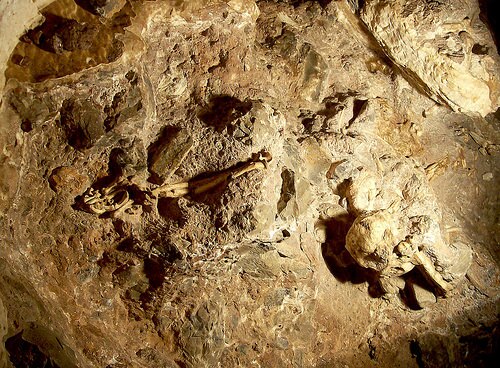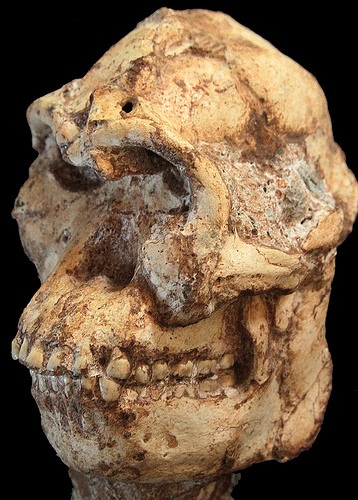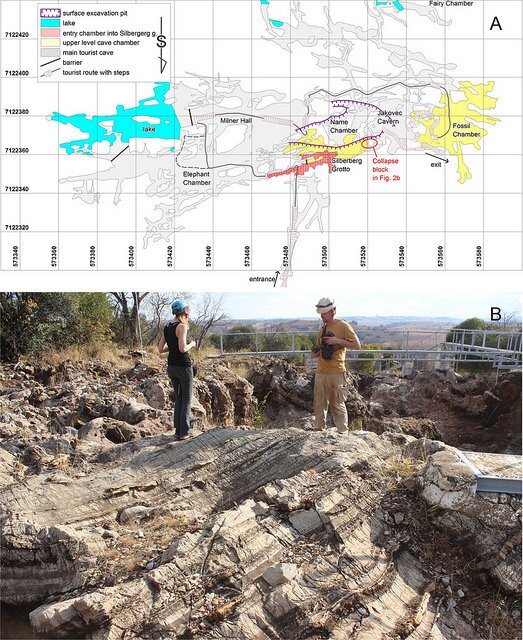
The famous Australopithecus fossilized skeleton known as “Little Foot“, the nearly complete articulated skeletal remains of a possible human ancestor, cannot be more than 2.8 million years old, according to a recent research study. This individual has previously been dated to approximatley 3.67 million years old. But based on research conducted by Jan D. Kramers of the University of Johannesburg and Paul H.G.M. Dirks of James Cook University, Little Foot may actually be over 800,000 years younger.
Interpreting the ages of hominin fossils is very important for understanding the timeline of human evolution. Little Foot, a complete Australopithecus skeleton found in 1997/1998 in sediments of the Silberberg Grotto in the Sterkfontein Caves, has played into this. But the age of the find has been beset by scholarly debate for years. Based on the abundance in quartz of the radioactive isotopes 26Al and 10Be, which accumulate at the surface due to cosmic rays, Granger et al. (Nature 2015;522:85–88) previously determined that the sediments surrounding Little Foot had been underground for 3.67±0.16 million years, and thus concluded this age for the fossil. Kramers and Dirks, however, recently re-examined the data in detail and found that the breccia deposit encasing Little Foot, and therefore the fossil itself, cannot be older than about 2.8 million years based on dating of chert fragments within the breccia mix encasing the skeleton. So why the inconsistent mix of dates? To resolve the paradox of the two ages, they propose that Little Foot, when alive, may have fallen from a higher-level cave chamber, shown to have once existed immediately above the Silberberg Grotto. Sediments older than 2.8 million years may have flowed into and were deposited in the lower chamber over time, encasing Little Foot. Subsequently, the older sediments characterizing the upper chamber were eroded away over time in the upper chamber, but remained preserved in the lower chamber. The case of Little Foot’s age is therefore not yet closed.
______________________________________
General view of Little Foot skeleton in its original position in Sterkfontein cave, November 2006. 120 / V. Mourre, Wikimedia Commons
______________________________________
The Little Foot skull, removed from its breccia context. Courtesy Wits University, Wikimedia Commons
__________________________________________________
Prominent surface feature at Sterkfontein and its relation to the Silberberg Grotto. (a) Cave map showing the position of surface workings, entry chambers and (b) relative to the Silberberg Grotto. (b) View from the east of a large tilted dolomite block on the south side of the open excavation, adjoining breccia of Member 4. (a) Source: Adapted from Martini et al.41; (b) Photo: Paul Dirks
___________________________________________________
The recent study has been published in the South African Journal of Science, Academy of Science of South Africa.
Article Source: Adapted and edited from the South African Journal of Science press release.
___________________________________________________
Subscribe to Popular Archaeology Premium. Available on all laptops and mobile devices, and still the industry’s best value at only $9.00 annually.
___________________________________________
Travel and learn with Far Horizons.
____________________________________________
This richly illustrated issue includes the following stories: Recent findings shedding new light on the whereabouts of the remains of Philip of Macedon, father of Alexander the Great; how an archaeologist-sculptor is bringing bones of the dead back to life; archaeologists uncovering town life at the dawn of civilization; an exclusive interview with internationally acclaimed archaeologist James M. Adovasio about what makes the Meadowcroft Rockshelter prominent in the ongoing search for the first Americans; what archaeologists are finding at the site of the ancient city of Gath, the home town of the biblical Philistine giant, Goliath; and how scientists are redrawing the picture of human evolution in Europe. Find it on Amazon.com.









